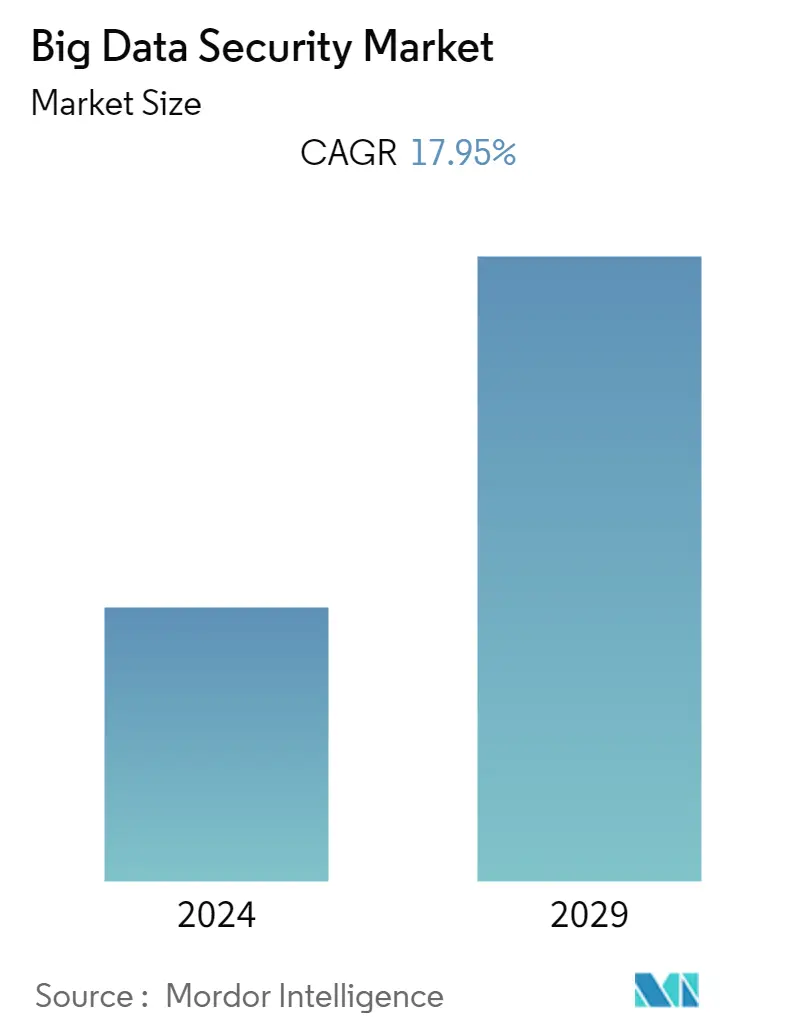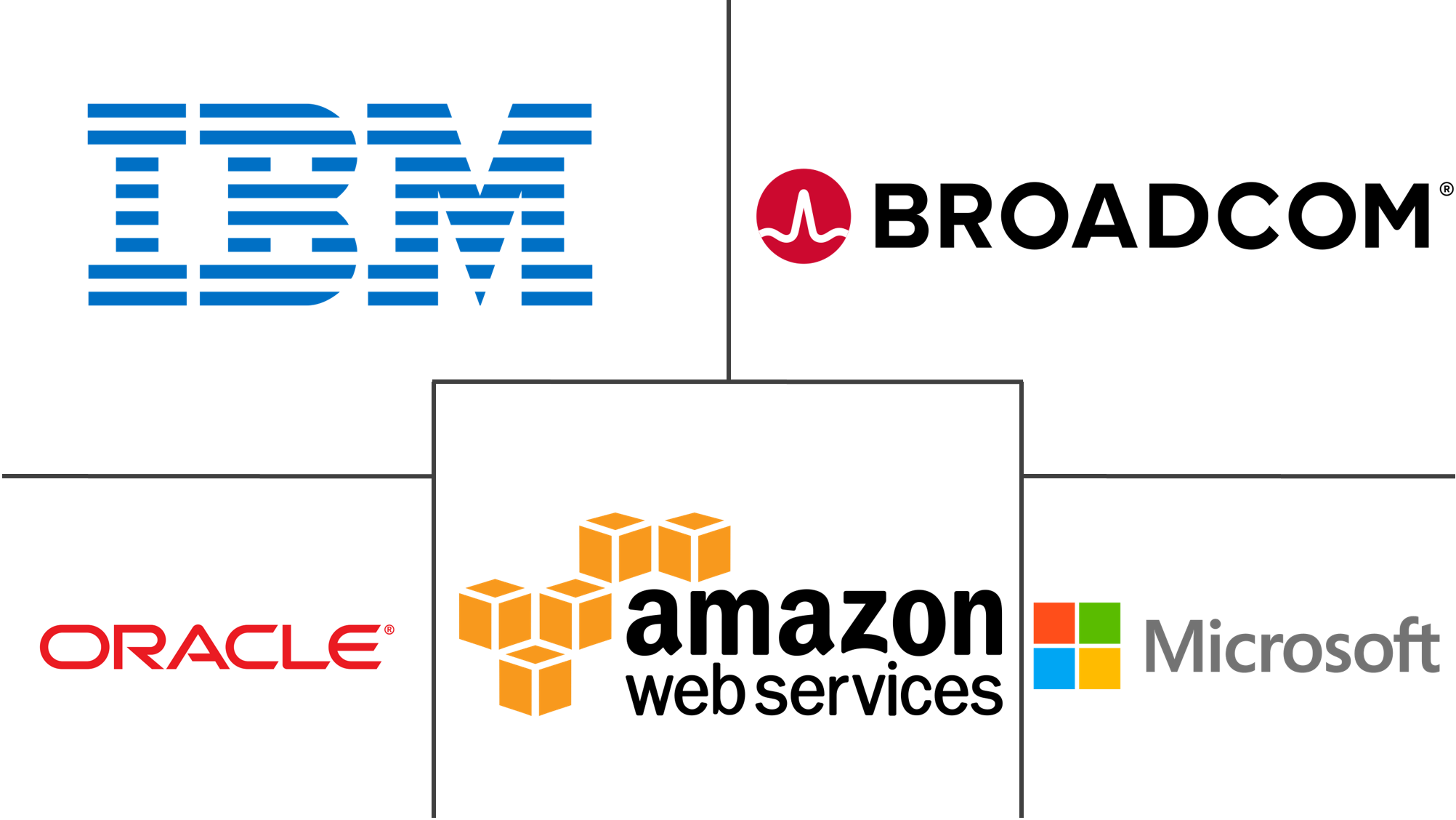Market Size of Big Data Security Industry

| Study Period | 2019 - 2029 |
| Base Year For Estimation | 2023 |
| CAGR | 17.95 % |
| Fastest Growing Market | Asia-Pacific |
| Largest Market | North America |
| Market Concentration | Low |
Major Players
*Disclaimer: Major Players sorted in no particular order |
Big Data Security Market Analysis
The big data security market is expected to register a CAGR of 17.95% over the forecast period. Security is a significant concern that restricts enterprises from opting for big data deployments on-premise, hosted on the cloud, or in virtual environments.
- When cybercriminals target large data sets, the payoff is frequently well worth the effort required to breach security layers, which is why big data has major potential for businesses and cyber criminals. They have a lot more to gain when they go after such a massive data set. As a result, companies lose a lot more if they are subjected to a cyberattack without adequate security measures.
- Many companies, especially those that deal with huge amounts of data, need traditional data mining and cyber-attack protection tools and techniques.As a result, cybersecurity professionals are increasingly turning to big data analytics. With data being routed through a circuitous path from a data source (such as CRM or sensors) to data storage and analysis, the big data environment is vulnerable and a valuable target for intruders.
- Although enterprises deploy big data platforms using the Hadoop open-source framework or other sources, the frameworks need comprehensive security plans. The inherent mechanisms have limitations that may need to be secured more than just by data encryption; many tech companies are bringing cloud solutions to the market to solve this issue. For instance, in August 2021, McAfee Enterprise announced that MVISION Cloud is a secure access service edge (SASE) offering called MVISION Unified Cloud Edge (UCE). This solution extends the capabilities of Dynamics 365 by utilizing a frictionless API-based cloud-native approach; this demands the security of big data in enterprises.
- The worldwide COVID-19 pandemic benefited the global market. The big data security industry was predicted to rise following the COVID-19 pandemic, as many organizations were forced to switch to working from home and remote working modes due to the fast spread of coronavirus around the globe. As a result of increasing online activity and growth in cyber-attack frequency, masses of new raw data were created, propelling the growth of the big data security market.
According to Cyber Risk Management, the amount of data compromises in the U.S. reached 817 in the first half of last year. During the same period, over 53 million people were harmed by data thefts, including data leaks, breaches, and exposure. In addition to the COVID pandemic, more people are working from home because they don't have the same level of protection or deterrent measures as those who work in an office (e.g., internet security).
Big Data Security Industry Segmentation
Big data security is the aggregate term for all the measures and tools used to safeguard and defend the data and analytics processes from attacks, theft, or other malicious activities that could harm or negatively affect them. The scope comprises components, organization size, end-users, and geography. The market is segmented by component (solutions, services), organization size (small and medium enterprises, large enterprises), end-user industry (banking, financial services, and insurance (BFSI), manufacturing, IT & telecommunications, aerospace & defense, healthcare, and other end-users), and geography (North America, Europe, Asia Pacific, Latin America, and the Middle East and Africa).
The market sizes and forecasts are provided in terms of value (USD million) for all the above segments.
| By Component | |
| Solutions | |
| Services |
| By Organization Size | |
| Small & Medium Enterprises | |
| Large Enterprises |
| By End-user Industry | |
| Banking, Financial Services, & Insurance (BFSI) | |
| Manufacturing | |
| IT & Telecommunication | |
| Aerospace & Defense | |
| Healthcare | |
| Other End-users |
| By Geography | ||||||
| ||||||
| ||||||
| ||||||
| ||||||
|
Big Data Security Market Size Summary
The big data security market is poised for significant growth, driven by the increasing need for robust security measures as enterprises adopt big data technologies across various platforms, including on-premise, cloud, and virtual environments. The rise in cyberattacks targeting large data sets underscores the critical importance of securing these environments, as breaches can lead to substantial losses for businesses. Companies are increasingly leveraging big data analytics to enhance their cybersecurity posture, addressing vulnerabilities in data routing and storage processes. The market is further propelled by the adoption of advanced security solutions, such as McAfee's MVISION Unified Cloud Edge, which integrates cloud-native approaches to safeguard big data deployments. The COVID-19 pandemic has accelerated this trend, as remote work arrangements have led to increased online activity and a surge in cyber threats, highlighting the necessity for comprehensive big data security solutions.
In the manufacturing sector, the integration of smart manufacturing techniques and the Internet of Things (IoT) has created a more connected environment, which, while improving operational efficiency, also exposes companies to heightened cybersecurity risks. Cyberattacks, including ransomware and denial-of-service attacks, have become prevalent, causing significant operational disruptions and financial losses. The demand for big data security solutions is further amplified by the need to protect intellectual property and sensitive data in an increasingly digital landscape. Major players in the market, such as Oracle, Microsoft, and IBM, are investing heavily in research and development to enhance their security offerings and maintain a competitive edge. Strategic partnerships and collaborations, like those between Seclore and TD SYNNEX, and Anaconda Inc. and Oracle Cloud Infrastructure, are also shaping the market dynamics, providing enterprises with comprehensive data protection solutions. As the volume of big data continues to grow, so does the demand for effective security measures, positioning the big data security market for substantial expansion in the coming years.
Big Data Security Market Size - Table of Contents
-
1. MARKET DYNAMICS
-
1.1 Market Overview
-
1.2 Introduction to Market Drivers and Restraints
-
1.3 Market Drivers
-
1.3.1 Increasing Variety And Volume of Business Data Generated from Various Sources
-
1.3.2 Increasing Cyber-Attacks Demand for Scalable High Security Solutions
-
1.3.3 Growth of E-Commerce Industry
-
-
1.4 Market Restraints
-
1.4.1 Lack of Data Security Awareness
-
1.4.2 Low Data Security Budget And High Installation Cost of Solution
-
1.4.3 Lack of Security Expertise And Skilled Personnel
-
-
1.5 Industry Attractiveness - Porter's Five Forces Analysis
-
1.5.1 Bargaining Power of Buyers/Consumers
-
1.5.2 Bargaining Power of Suppliers
-
1.5.3 Threat of New Entrants
-
1.5.4 Threat of Substitute Products
-
1.5.5 Intensity of Competitive Rivalry
-
-
1.6 Impact of COVID-19 on the market
-
-
2. MARKET SEGMENTATION
-
2.1 By Component
-
2.1.1 Solutions
-
2.1.2 Services
-
-
2.2 By Organization Size
-
2.2.1 Small & Medium Enterprises
-
2.2.2 Large Enterprises
-
-
2.3 By End-user Industry
-
2.3.1 Banking, Financial Services, & Insurance (BFSI)
-
2.3.2 Manufacturing
-
2.3.3 IT & Telecommunication
-
2.3.4 Aerospace & Defense
-
2.3.5 Healthcare
-
2.3.6 Other End-users
-
-
2.4 By Geography
-
2.4.1 North America
-
2.4.1.1 United States
-
2.4.1.2 Canada
-
-
2.4.2 Europe
-
2.4.2.1 United Kingdom
-
2.4.2.2 Germany
-
2.4.2.3 France
-
2.4.2.4 Rest of Europe
-
-
2.4.3 Asia-Pacific
-
2.4.3.1 China
-
2.4.3.2 Australia
-
2.4.3.3 Rest of Asia-Pacific
-
-
2.4.4 Latin America
-
2.4.4.1 Brazil
-
2.4.4.2 Mexico
-
2.4.4.3 Rest of Latin America
-
-
2.4.5 Middle-East & Africa
-
2.4.5.1 United Arab Emirates
-
2.4.5.2 Saudi Arabia
-
2.4.5.3 South Africa
-
2.4.5.4 Rest of Middle-East & Africa
-
-
-
Big Data Security Market Size FAQs
What is the current Big Data Security Market size?
The Big Data Security Market is projected to register a CAGR of 17.95% during the forecast period (2024-2029)
Who are the key players in Big Data Security Market?
Oracle Corporation, Microsoft Corporation, Broadcom Inc. (Symantec Corporation), IBM Corporation and Amazon Web Services are the major companies operating in the Big Data Security Market.

